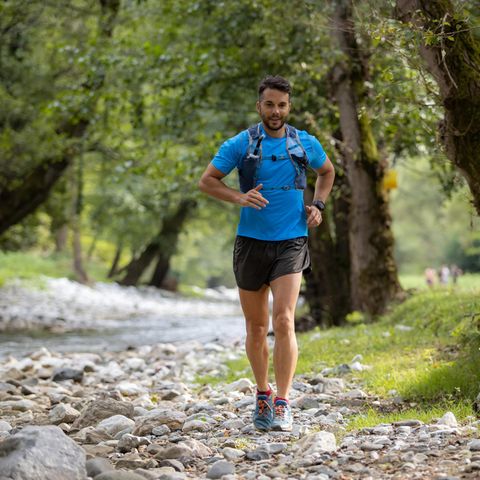Stay flexible
Gravel Running: The new running trend off the asphalt
How Gravel Running has just conquered the sports market, what you need to know and what equipment it needs for the cross route-explained in a practical way.
After the gravel bikes, a symbiosis of racing bike and mountain bike, the focus of runners is also moving to forest and dirt roads: Gravel Running grows as a separate discipline between road and trail. While smooth surface and precise rotary movements dominate during the road run, gravel is required for gravel running running a more robust technology, better grip and versatile damping. If you often travel on forest paths and rolling gravel sections, you will quickly learn that not every street or trail shoe combination is ideal: Gravel Running requires shoes that offer both a good traction on a relaxed surface as well as cushioning bumps on hard ways.
Unlike classic trail running, which often opens up technical, rooted paths or muddy routes, Gravel Running is often easier to access. Local edge paths and business routes become running routes that can be accessed quickly, but without high technical requirements. For runners with asphalt training, this is a welcome change – you can vary pace and terrain without having to switch directly to demanding trails.
The Gravel concept combines everyday suitability with an adventure character and addresses a growing target group of people who are looking for freedom between street and nature. The strategy is: remain flexible.
What gravel running distinguishes
Gravel Running is not fashion, but a functional style. Roads, gravel roads, solid forest paths and occasional trails alternate. The conditions are more varied than in the usual street run. This type of running places special requirements for shoes, technology and equipment. Shoes for Gravel Running combine streets with coarse grip, stable but reactive material, and protection against stones or roots. The damping must compensate for a wide variety of substrates. At the same time, the equipment is gaining in importance: a light running backpack or a hydration vest is often part of standard equipment, as well as technical clothing, airy, quick-drying tops and running stockings protecting from blowing. Gravel Running also promotes a different running technique: shorter, more conscious steps, an upright attitude and adaptability in the event of changing substrates.
In practice, it shows how Gravel Running also affects beginners: Anyone who has been used to asphalt so far quickly learns that gravel feels differently – through feathers, but also by luring small pebbles in the shoe. Anyone who makes a route, such as a time window between the office and everyday life, can be traced from asphalt to dirt road and back without changing the equipment. The load also changes: the body reacts differently to rolling surface, the joints experience other thrusts. A drinking system is often also included for regular gravel runners. For example, a running vest or a drinking bag that transports a minimalist luggage and water without hindering the movement.
Shoes and equipment for Gravel Running
In everyday life, gravel runners can already equip themselves with equipment that also works in normal running training. Two current models are particularly suitable:
The is explicitly developed as a gravel shoe: according to tests, a light all-rounder with a contam gip outsole and comfortable upholstery, which offers good traction and stability on both asphalt and loose gravel. The model was mentioned in current trail shoe tests as a top recommendation for road-to-trail inserts. In reports, his relaxed, spacious cut is praised, which still gives enough support on the foot.
The rely on maximum damping with Energy Foam Evo. The material pays off when long runs are planned with many substrates. The breathable 3D mesh and the fit should ensure a pleasant seat, even in changeable weather and longer distances. It combines comfort with specific gravel requirements and was identified as ideal for mixed runs in current product recommendations.
In conjunction with these shoes, an ideally recommended is a hydration vest or a minimalist running backpack models such as the or the Work perfectly because they are already optimized in fit and lightness than pure trail running products. Experts lead them as lightweight solutions sitting close to the body, do not disturb the movement and offer sufficient drinking volume for runs up to several hours.
How runners can implement the style in everyday life
For example, Gravel Running can look like this in everyday life: run a 30-minute round of combined asphalt and gravel paths in the morning before work, comfortably with a drinking system in the back; Later a section on the dirt road or promenade – so far trained intervals and distances can be divided into various available routes and adopted without a major change. Because there are often fewer opportunities to accommodate in rain than that of runs in the city, it is advisable to add a feather -light rain jacket to the equipment, such as the or for runners the . Both fit small folded in the drinking bag.
In the long term, body awareness also grows with such routine: the runner feels how leg and foot muscles stabilize how bumps are less irritating, and how the change between soft surface and solid asphalt becomes an almost meditative running rhythm. The equipment has a connecting effect: instead of moving and extra equipment, a well -coordinated combination of shoe, vest, base layer and socks is sufficient. Gravel Running does not become an effort, but to the daily expansion of the usual running route.
*This article contains so-called affiliate links to products in online shops. If a user clicks on it and buys something, the publisher receives a commission from the dealer, not from the manufacturer. Of course, where and when you buy a product is up to you.
Source: Stern
I am Pierce Boyd, a driven and ambitious professional working in the news industry. I have been writing for 24 Hours Worlds for over five years, specializing in sports section coverage. During my tenure at the publication, I have built an impressive portfolio of articles that has earned me a reputation as an experienced journalist and content creator.




